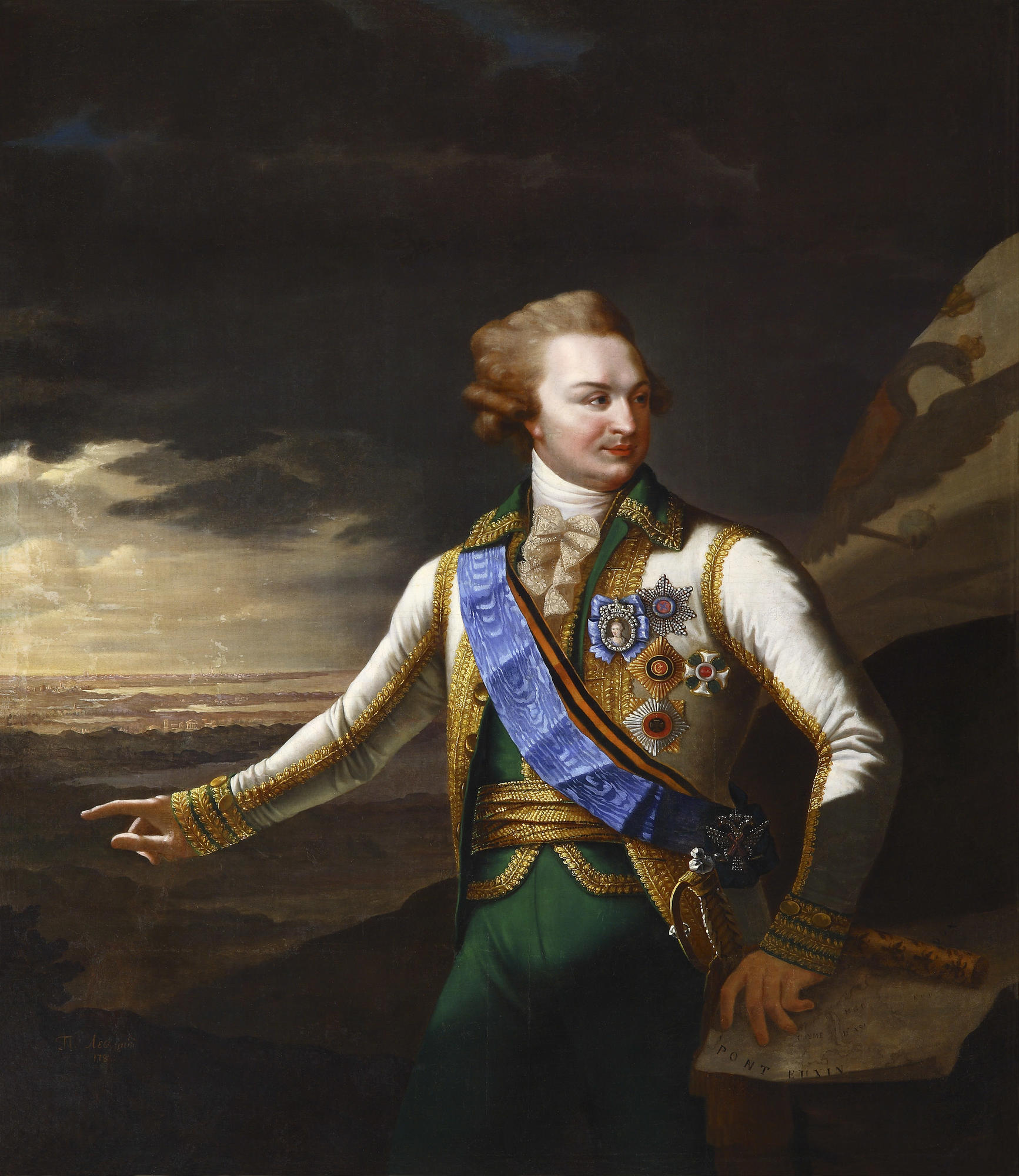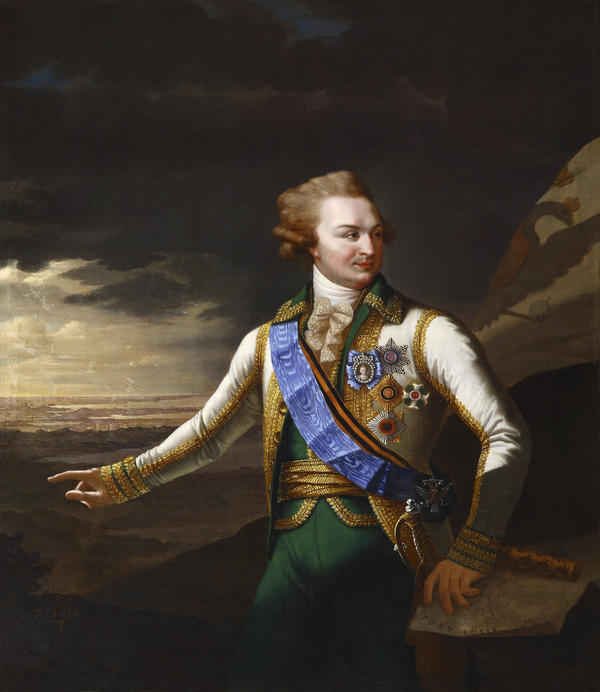Gregory Alexandrovitch Potemkin was born in 1739 in Smolensk Province in the family of a landlord. Potemkin was educated at the gymnasium of Moscow University. Then he entered the Moscow University, where a year later he was awarded a gold medal for his success in science. Later, Empress Elizabeth Petrovne was introduced among the best 12 students. And in 1760 he was expelled from the Moscow University ‘For Leniency and Absence from Classes’.
To the first military rank Potemkin was presented in absentia — he was recorded in the Horse Guard with the opportunity to continue training. After being expelled from the university, he had the rank of wahmistra — assistant commander. Empress Catherine II drew attention to Potemkin during the palace coup. For his participation in the coup he was promoted to sub-lieutenant, received the rank of camera-junker and 400 souls of serfs. From that point on, Potemkin 's rapid military and diplomatic career began.
In 1769, he volunteered for the Turkish War and was awarded the Order of St. George III degree for the feats. Gregory Potemkin took an active part in the suppression of the Pugachev uprising. After that he was appointed Count, and a year later Prince of the Holy Roman Empire with the title of lightest.
In 1775 Potemkin was appointed Governor-General of the New Russia Region. The Prince was engaged in the development of Novorossia, under his leadership the construction of the cities of Kherson, Sevastopol, Ekaterinoslav was carried out. Potyomkin 's important business was the creation of the Black Sea Fleet.
On his initiative, the Crimean Peninsula was annexed to Russia in 1783. For this Potemkin received the honorary name Tavrici.
In 1784 Potemkin received the rank of Field Marshal General and was appointed President of the Military College. The Prince carried out military reform: changed the line service and equipment of the troops. For example, he eliminated the fashion for scallops, wigs, powder, introduced thin boots.
He was Commander-in-Chief of the Russian Army in the Russo-Turkish War of 1787-1791, led the capture of Ochakov, contributed to the career of Suvorov and Kutuzov.
The front generation portrait of the luminous prince is copied from the portrait of Levitsky 's brush. Levitskiya ̆ always appreciated an opportunity to show greatness of the person, to glorify his advantages in a ceremonial portrait. Heroes ̆ a portrait — not just famous person, but the statesman. On the portraits of the artist the depicted appears in the most solemn form. The background and environment around him tell about the significance of his acts.
Levitsky, during the rise of his creativity, created a portrait gallery of cultural figures in the 1780s. By this time there is a portrait of Potemkin against the background of Sevastopol. On the portrait Potemkin is dressed in the uniform of an officer of the Preobrazhenskiy Regiment. The white uniform on the chest is open, exposing the white neck handkerchief and lace jab. On the right side of the chest a miniature portrait of Empress Catherine II in a diamond frame, diamond signs of high awards of Russia. Under the blue muar ribbon of the Order of St. Andrei the Original there is a ribbon of George 's weapons fixed to the ephesus of the sabre. The artist stressed the loyalty of the luminous prince, painting on the portrait the coat of arms of the Russian Empire. With his right hand Potemkin points to the Akhtiar Bay of Sevastopol, convenient for parking military vessels, at the left hand there is a map of Tavrida.
To the first military rank Potemkin was presented in absentia — he was recorded in the Horse Guard with the opportunity to continue training. After being expelled from the university, he had the rank of wahmistra — assistant commander. Empress Catherine II drew attention to Potemkin during the palace coup. For his participation in the coup he was promoted to sub-lieutenant, received the rank of camera-junker and 400 souls of serfs. From that point on, Potemkin 's rapid military and diplomatic career began.
In 1769, he volunteered for the Turkish War and was awarded the Order of St. George III degree for the feats. Gregory Potemkin took an active part in the suppression of the Pugachev uprising. After that he was appointed Count, and a year later Prince of the Holy Roman Empire with the title of lightest.
In 1775 Potemkin was appointed Governor-General of the New Russia Region. The Prince was engaged in the development of Novorossia, under his leadership the construction of the cities of Kherson, Sevastopol, Ekaterinoslav was carried out. Potyomkin 's important business was the creation of the Black Sea Fleet.
On his initiative, the Crimean Peninsula was annexed to Russia in 1783. For this Potemkin received the honorary name Tavrici.
In 1784 Potemkin received the rank of Field Marshal General and was appointed President of the Military College. The Prince carried out military reform: changed the line service and equipment of the troops. For example, he eliminated the fashion for scallops, wigs, powder, introduced thin boots.
He was Commander-in-Chief of the Russian Army in the Russo-Turkish War of 1787-1791, led the capture of Ochakov, contributed to the career of Suvorov and Kutuzov.
The front generation portrait of the luminous prince is copied from the portrait of Levitsky 's brush. Levitskiya ̆ always appreciated an opportunity to show greatness of the person, to glorify his advantages in a ceremonial portrait. Heroes ̆ a portrait — not just famous person, but the statesman. On the portraits of the artist the depicted appears in the most solemn form. The background and environment around him tell about the significance of his acts.
Levitsky, during the rise of his creativity, created a portrait gallery of cultural figures in the 1780s. By this time there is a portrait of Potemkin against the background of Sevastopol. On the portrait Potemkin is dressed in the uniform of an officer of the Preobrazhenskiy Regiment. The white uniform on the chest is open, exposing the white neck handkerchief and lace jab. On the right side of the chest a miniature portrait of Empress Catherine II in a diamond frame, diamond signs of high awards of Russia. Under the blue muar ribbon of the Order of St. Andrei the Original there is a ribbon of George 's weapons fixed to the ephesus of the sabre. The artist stressed the loyalty of the luminous prince, painting on the portrait the coat of arms of the Russian Empire. With his right hand Potemkin points to the Akhtiar Bay of Sevastopol, convenient for parking military vessels, at the left hand there is a map of Tavrida.



